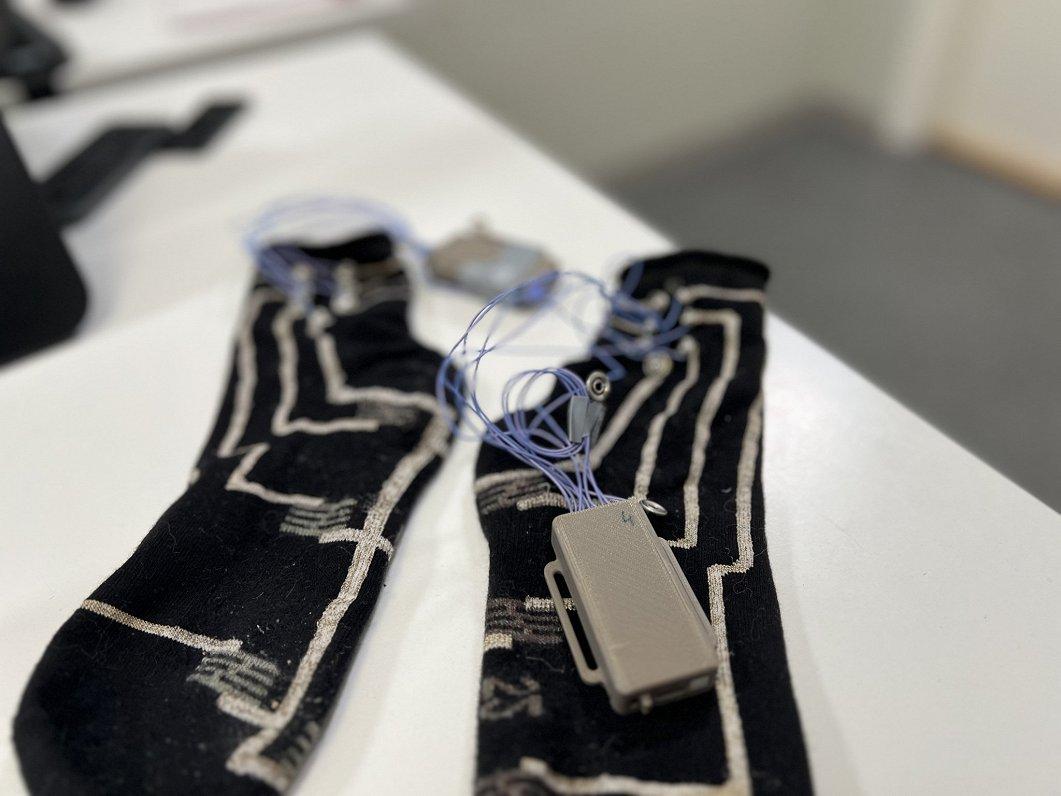Innovative socks designed to reduce injury risk for athletes have been developed by three Latvian universities. Although these socks could be used by a much wider audience in the future, this year’s project, valued at 300,000 euros, focuses on young football players in Latvia, who face a high risk of injuries. How do these socks work?
Project leader Guna Semjonova, a lecturer at the Faculty of Health and Sports Sciences at Riga Stradiņš University, explains how the soft, seemingly ordinary garment is designed. Six metallic-like buttons are sewn onto the outside of the sock, each connected to a thin wire. These wires connect to a small plastic box that sends signals to a computer.
"The socks have integrated sensors woven inside. There are six sensors positioned near the toes, in the midfoot, and at the heel. The sensors consist of threads that can change electrical resistance in response to pressure. When we press on a sensor, you can see the changes…," Semjonova demonstrates.

Photo: Viktors Demidovs
When standing in the sock, changes appear immediately on a graph in the computer program showing six curves. If the weight is balanced correctly, meaning the center of gravity is centered over the foot, the curves do not rise above the average value.
"If my sixth sensor shows that the curve remains unchanged, then I will know that I might not be standing on my heel, for example, when I’m doing a squat."
The socks can be useful for everyone, but this project specifically targets Latvian football players up to the age of 14, who have a very high risk of injury.
"Through the readings and the correction of foot position, which also corresponds to the correction of the lower limb's position, we can proactively reduce the risk of injury, thus lowering both the costs associated with treating those injuries and encouraging young people to return to playing and participating in their beloved activities," Semjonova explains.
The idea was conceived by specialists at Riga Technical University in 2011. Several years later, researchers from Riga Stradiņš University and Vidzeme University of Applied Sciences joined the project. Among the specialists is Sergejs Davidovičs, a physiotherapist from the Latvian Football Federation.
"There are aspects that need improvement. We are currently working on having players wear virtual reality glasses while putting on the socks, allowing them to see if they are performing exercises correctly. This could be one of the milestones achieved, possibly within the next two years. Whether it will yield results will need to be assessed over a longer period, looking at how injuries are affected in the long term. It is known that there are many young football players aged 12, 13, and 14, but at 15, 16, or even younger or older, they get injured, and some even stop playing football.
It’s important that we can protect as many people as possible from injuries. Thus, this is a significant step forward in sports medicine and the development of football," Davidovičs says.
The study has produced 50 pairs of socks. Plans are in place to produce them for a wider audience; however, no commercial interest has yet been shown, Semjonova admits, adding that a similar study is being conducted at Osaka University in Japan, where there is interest in the Latvian invention. To explore potential collaboration, the researcher plans to visit Japan this week.
Source: lsm.lv
